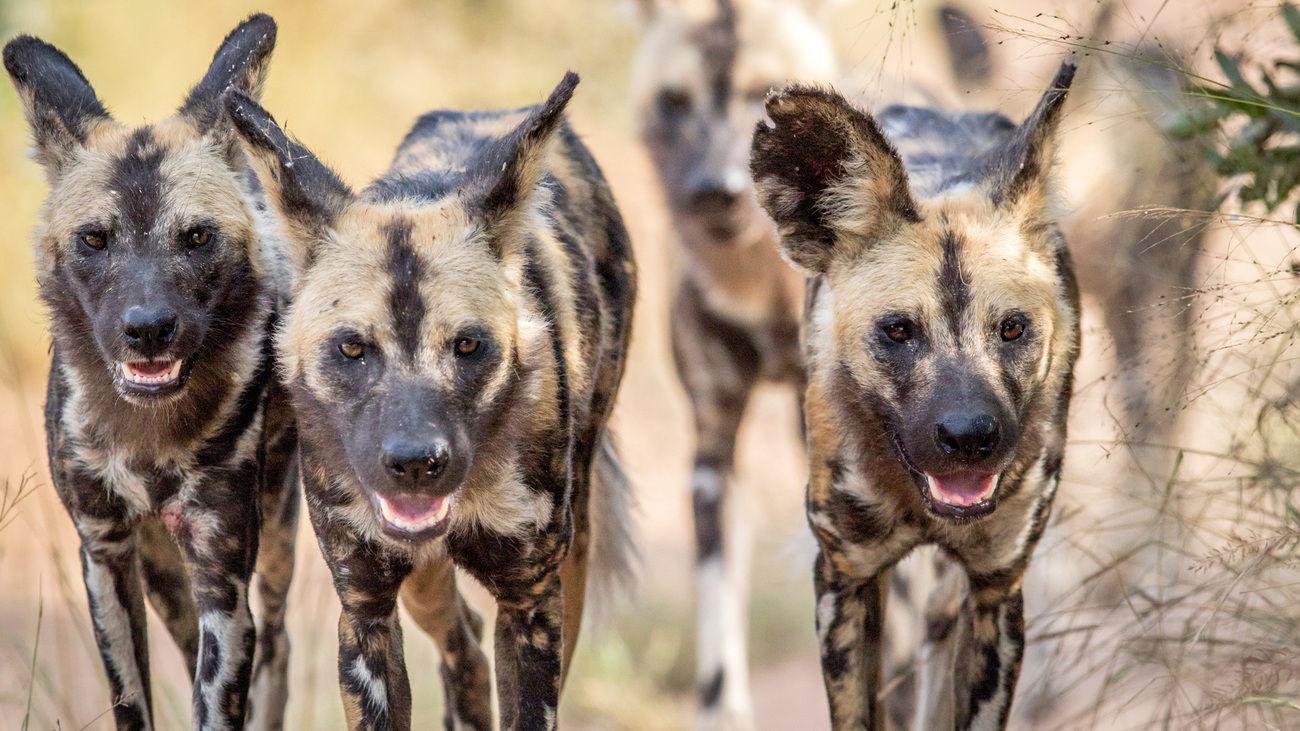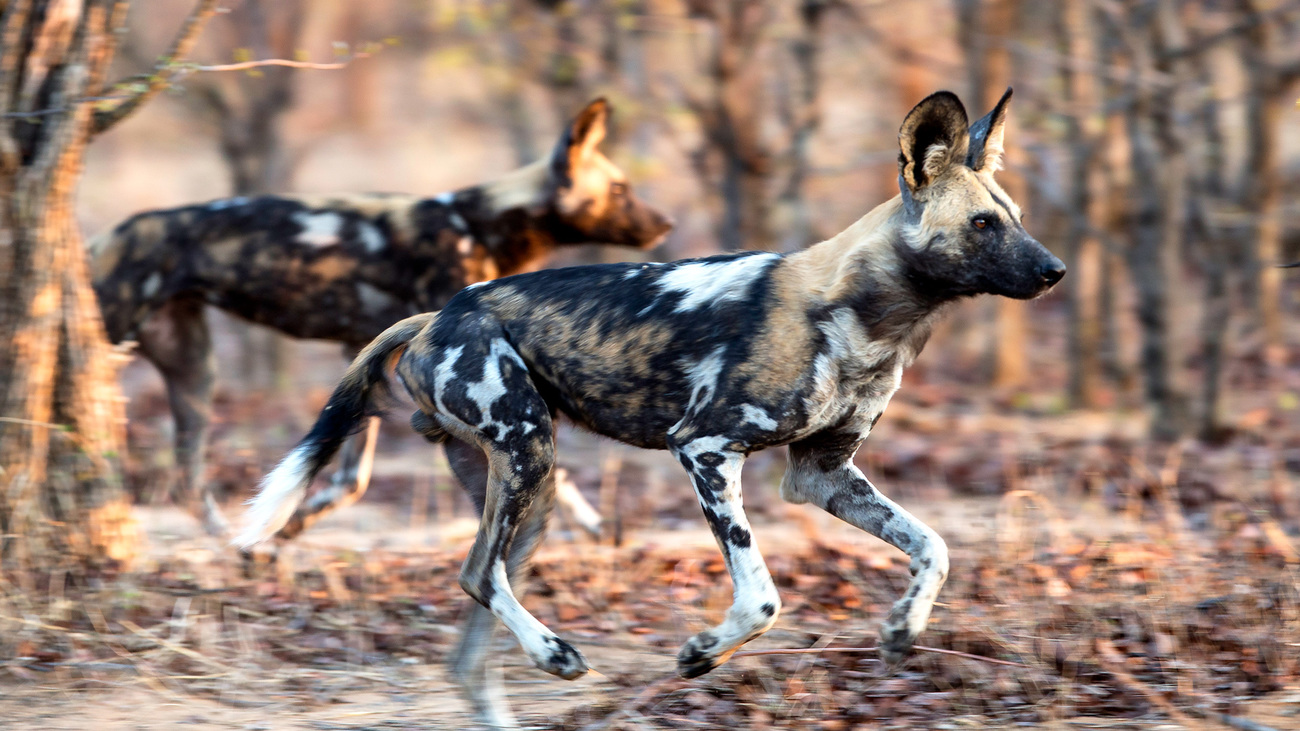African wild dogs
African wild dogs are an elusive member of Africa’s fauna. They live and hunt in packs that are widely dispersed and never stay in one place for long. They can travel up to 50 kilometres per day and occupy territories of up to 1,500 square kilometres.
African wild dogs have a unique social structure that differs from most other pack animals. Each pack includes up to 20 members and is led by a dominant breeding pair (the alpha male and alpha female) with the rest of the members working as subordinates. The most unusual part is that the females (rather than the males) migrate to new packs after reaching maturity.
Pack members communicate with each other through a variety of touches, tail wags, and vocalisations. They have strong collaborative relationships, working together to hunt for food and taking care of all pups as a pack. They rarely fight amongst themselves or try to usurp the dominant position. They also look after injured, ill, or elderly members of the pack by sharing food, even when the weak individual can’t participate in the hunt.
As a predator species, they help keep the number of prey species under control, preventing habitat destruction and overfeeding. They are also an important food source for larger predators like lions.
What is an African wild dog’s scientific name?
The African wild dog’s scientific name is Lycaon pictus, which means ‘painted wolf’ in Greek and Latin. The name refers to its mottled fur pattern, which includes hues of red, black, brown, white, and yellow. Each individual dog’s coat has a unique pattern.
Are African wild dogs endangered?
African wild dogs are listed as endangered on the IUCN Red List and have been since 1990. Their numbers continue to decrease due to a range of factors, including habitat fragmentation, human-wildlife conflict, and infectious diseases.
Where do African wild dogs live?
African wild dogs once roamed across much of Sub-Saharan Africa, absent only in areas of lowland rainforest and particularly dry desert. Now, though, they have disappeared from most of their former range.
While they still live in open plains and sparse woodlands, African wild dogs can only be found in small numbers in southern Africa. Their range is limited to Botswana, western Zimbabwe, eastern Namibia, and western Zambia.
Threats
African wild dogs face a number of threats, including habitat fragmentation, human-wildlife conflict, and infectious disease. Unfortunately, these threats are all caused by the increasing presence of human settlements in African wild dog habitats.

Habitat fragmentation
Habitat fragmentation happens when an animal’s range is broken up by expanding human settlements. This has occurred in African wild dogs’ habitat, where the animals can no longer travel from one area to another without passing through farm and grazing land.
This fragmentation not only triggers human conflict and spreads infectious diseases (see below for details) but it can also affect African wild dogs’ reproductive rates, as they become unable to travel easily and find new mates.
Human-wildlife conflict
Although African wild dogs prefer to hunt and eat wild prey, they have been known to target livestock when wild prey is scarce. The more human settlements, farms, and grazing land there is in an area, the more likely it is to affect their usual hunting habits and lead to livestock hunting.
Because the farmers in these areas rely on their livestock for their livelihoods, they take extreme measures to keep their animals safe. As a result, African wild dogs are often hunted and killed by farmers.
Infectious disease
Infectious disease is another side effect of African wild dogs and humans living in close proximity.
Wild dogs are susceptible to diseases like rabies and canine distemper, which are carried by domestic dogs. Because wild dogs stay close together, these diseases spread quickly, often wiping out entire packs.
FAQs

What do African wild dogs eat?
African wild dogs eat a range of animals based on the prey available in the area. When hunting alone, they typically prey on smaller animals like wildebeest calves, rats, and birds. However, they also hunt in packs to target larger prey, like antelopes and mature wildebeests, relying on their stamina and teamwork.
How do African wild dogs hunt?
African wild dogs hunt in large packs of 20 individuals or more and have a seemingly complex hunting ritual.
Before initiating a hunt, they gather together and circulate among each other, touching and communicating to spur each other on for the hunt ahead. Towards the end of this ritual, they start sneezing. The reason for this is uncertain, but one theory suggests that the sneezes are a complex voting system that helps the pack decide whether they should begin the hunt.
Together, they target large prey like antelopes and, when the opportunity arises, wildebeest (though typically only when they’re ill or injured). They have high success rates when hunting (around 80%) thanks to their strong teamwork. They approach prey silently to get as close as possible before initiating a chase. Using their numbers, they surround the prey so it can’t escape and slowly wear down its stamina.
How big are African wild dogs?
African wild dogs are between 75 and 110 centimetres long with 31 to 41-centimetres tails. They are around 60 centimetres tall at the shoulder and weigh between 18 and 36 kilograms.
They’re lean and tall with oversized ears and have just four toes on each paw (instead of five on each front foot and four on each rear foot, like other canines).

How fast can African wild dogs run?
Thanks to their slim bodies and long, strong legs, African wild dogs can reach speeds of up to 72 kilometres per hour and retain high speeds for long stretches of time. Their large circular ears help them regulate their body heat, increasing their stamina in the hot African climate.
What is the largest wild dog in Africa?
The Lycaon pictus, or African wild dog, is the largest wild dog in Africa and the third largest in the world.
How long do African wild dogs live?
Much like domestic dogs, African wild dogs have a relatively short lifespan. They can live up to 11 years in the wild.
Are African wild dogs dangerous?
African wild dogs are pack animals that are quick to defend themselves against any threatening animal. While they don’t prey on humans and typically approach them out of curiosity rather than aggression, it’s best not to go near them.
Can African wild dogs be domesticated?
Although African wild dogs belong to the Canidae (or canine) family and share common ancestry with domesticated dogs, they display different behaviours that make them hard to domesticate.
African wild dogs do not show any willingness to be touched by humans. Without this trait, there’s no way to selectively breed African wild dogs or make them friendlier towards humans.
Are African wild dogs actually dogs?
Although they’re referred to as dogs, and are part of the Canidae (or canine) family, African wild dogs are not part of the same genus as other canines. Grey wolves, coyotes, dogs, and jackals are all in the Canis genus, whereas African wild dogs are the only living members of the Lycaon genus. They can’t breed with Canis species and can’t be domesticated.

Are African wild dogs hyenas?
African wild dogs and hyenas are similar in appearance and live in the same areas but they are not the same species. Instead, African wild dogs belong to the Canidae (or canine) family, whereas hyenas belong to the Hyaenidae family.
One of the most prominent differences between the two animals is their size and fur pattern. African wild dogs are much smaller than hyenas and have a mottled fur pattern instead of a spotted one. African wild dogs also have much larger, rounded ears that point upwards.
What is an African wild dog called?
African wild dogs have a number of common names, including painted dog, Cape hunting dog, and painted wolf. Their scientific name is Lycaon pictus.
Why are African wild dogs endangered?
Unfortunately, African wild dogs face many threats that are significantly reducing their numbers.
Because their natural habitat is being claimed for agricultural purposes (including farming and livestock grazing), African wild dogs are experiencing severe habitat fragmentation. This, in turn, increases their contact with humans, often leading to human-wildlife conflict as African wild dogs hunt livestock or damage property, and humans kill them in retaliation.
Domestic dogs living in these human settlements also spread diseases to African wild dogs. Viruses like canine distemper can wipe out entire packs.
How many African wild dogs are left?
According to the IUCN, there are an estimated 6,600 mature African wild dogs left. They live in 39 subpopulations.
Scientists believe that African wild dogs have always lived in very low-density areas—the largest known range of 43,000 square kilometres is home to only 800 individuals. This suggests that their current numbers won’t increase significantly unless they can once again extend their range and gain more space.
How can you help?
African wild dogs face many threats that are significantly reducing their numbers, such as habitat fragmentation, human-wildlife conflicts and disease.